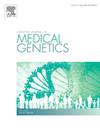Hexasomy of the 15q11q13 region: a detailed report and review of the literature
IF 1.7
4区 医学
Q3 GENETICS & HEREDITY
引用次数: 0
Abstract
Hexasomy of the Prader-Willi/Angelman Syndrome Critical Region (PWASCR; chromosome 15q11-q13) is very rare with only 13 patients being described to date. The region is known for its high susceptibility to genomic rearrangements, and extra copies within the region have been shown to be associated with distinct but variable clinical features of intellectual disability, epilepsy, global developmental delay amongst others. We present a 10-year-old girl with moderate to severe intellectual disability, cerebral palsy, seizures, autistic features and challenging behaviours. Her karyotype is 47,XX,+mar[25]/46,XX[5]. On chromosome analysis using G-banding, we identified a very large dicentric supernumerary marker chromosome 15q11-q13. Microarray analysis and metaphase fluorescence in-situ hybridisation using the SNRPN gene specific to 15q11.2-q13.3 region showed 87 % of cells containing 6 signals and 13 % of cells containing 2 signals. This represents mosaicism for a partial hexasomy of the long arm of chromosome 15q. We also reviewed and consolidated the literature of all reported patients with hexasomy of PWASCR, and found that amongst all 14 patients (including ours), despite some variation in phenotype, all patients had seizures, and the majority had intellectual disability and challenging behaviours.
15q11q13区域的六体:详细报道和文献综述。
Prader-Willi/Angelman综合征关键区六体;染色体15q11-q13非常罕见,迄今为止只有13例患者被描述。该地区因其对基因组重排的高度易感性而闻名,该地区的额外拷贝已被证明与智力残疾、癫痫、全面发育迟缓等独特但多变的临床特征有关。我们报告一名10岁女童,患有中度至重度智力残疾、脑瘫、癫痫发作、自闭症特征和具有挑战性的行为。她的核型是47、XX、+mar[5]/46、XX[5]。在染色体g带分析中,我们发现了一个非常大的双中心多余标记染色体15q11-q13。使用15q11.2-q13.3区域特异性SNRPN基因进行微阵列分析和中期荧光原位杂交显示,87%的细胞含有6个信号,13%的细胞含有2个信号。这代表了15q染色体长臂部分六体的镶嵌现象。我们还回顾并整合了所有报道的PWASCR六体患者的文献,发现在所有14例患者中(包括我们的患者),尽管在表型上有一些差异,但所有患者都有癫痫发作,并且大多数患者有智力残疾和挑战性行为。
本文章由计算机程序翻译,如有差异,请以英文原文为准。
求助全文
约1分钟内获得全文
求助全文
来源期刊
CiteScore
4.10
自引率
0.00%
发文量
193
审稿时长
66 days
期刊介绍:
The European Journal of Medical Genetics (EJMG) is a peer-reviewed journal that publishes articles in English on various aspects of human and medical genetics and of the genetics of experimental models.
Original clinical and experimental research articles, short clinical reports, review articles and letters to the editor are welcome on topics such as :
• Dysmorphology and syndrome delineation
• Molecular genetics and molecular cytogenetics of inherited disorders
• Clinical applications of genomics and nextgen sequencing technologies
• Syndromal cancer genetics
• Behavioral genetics
• Community genetics
• Fetal pathology and prenatal diagnosis
• Genetic counseling.

 求助内容:
求助内容: 应助结果提醒方式:
应助结果提醒方式:


